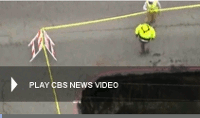
SL.CCS.1/2/3/4 Grades 6-12: An essay of a current news event is provided for discussion to encourage participation, but also inspire the use of evidence to support logical claims using the main ideas of the article. Students must analyze background information provided about a current event within the news, draw out the main ideas and key details, and review different opinions on the issue. Then, students should present their own claims using facts and analysis for support.
FOR THE WEEK OF APR 28, 2014
Eyes in the sky might help spot looming sinkhole risks on the ground
Here's good news for Florida, the sinkhole capital of America: Radar images from planes or satellites could someday predict where the earth seems about to collapse into deep, dangerous cavities. The idea of an early-warning system comes from new NASA research into a monstrous Louisiana sinkhole that opened in 2012, displacing hundreds of residents. When two space agency researchers examined earlier radar images of that area, they saw that the ground had begun shifting as much as 10 inches toward where the sinkhole started a month later. That 750-foot-deep crater has expanded to 29 acres and is still growing.
A newer sinkhole opened just last week between two homes in a retirement community north of Orlando, Fla. The sudden cavern – about 50 feet deep and 65 feet across – was filled with dozens of truckloads of dirt, but kept reopening. Last year, a sleeping man died when a sinkhole opened under his bedroom in Seffner, Fla. The state's geology makes it vulnerable to sinkholes because its soil rests uneasily on a porous foundation of limestone – which can be dissolved by groundwater, creating a void. When dirt, clay or sand gets too heavy for the weakened limestone, it can collapse.
Florida has started a three-year, $1-million project to identify which areas face the highest risks. A 2010 state report estimated that sinkholes each year cost Florida $200 million to $400 million. They also occur elsewhere, sometimes caused by oil drilling, mining or construction. One opened in February under the National Corvette Museum in Bowling Green, Kentucky, swallowing eight flashy sports cars on display.
![]() Researcher says: "Radar remote sensing could offer a monitoring technique for identifying at least some sinkholes before their surface collapse." – Ron Blom of NASA's Jet Propulsion Laboratory in Pasadena, Calif.
Researcher says: "Radar remote sensing could offer a monitoring technique for identifying at least some sinkholes before their surface collapse." – Ron Blom of NASA's Jet Propulsion Laboratory in Pasadena, Calif.
![]() Florida official says: "One of the more effective things we can do, is educate the public about the risks." – Aaron Gallaher, Division of Emergency Management
Florida official says: "One of the more effective things we can do, is educate the public about the risks." – Aaron Gallaher, Division of Emergency Management
![]() Insurance protection: Florida law requires that homeowners' insurance cover damage caused by sinkholes.
Insurance protection: Florida law requires that homeowners' insurance cover damage caused by sinkholes.
Front Page Talking Points Archive
►Mideast clashes spark fears Iran may block vital Strait of Hormuz trade route
►Typewriters aren't bygone relics: Old-school desktop devices gain new-generation users
►Deportation protests: Soldiers on the streets of L.A. pose a test of presidential power
►Hurricane season arrives and it could be more active than usual – 'a worrisome trend'
►New concerns increase appeal of European colleges for U.S. students
►White House signals possible challenge to a key legal right – court hearings before deportation
►Undersea warning sign: Coral bleaching spreads, weakening or killing vital tropical reefs
►Federal vaccine testing change concerns some medical experts
►Courts try to halt rushed removals of alleged gang members, testing presidential powers
